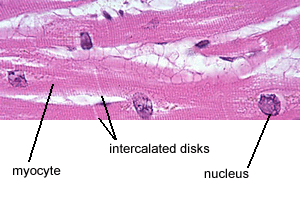Cardiac muscle
Cardiac muscle is a specialised form of muscle found only in the heart. Their contraction is autonomically regulated (no voluntary control) and will beat in rhythmic fashion for the life of the organism. Beats per minute range in humans, depending on fitness, from between 60 and 200 beats per minute.

Such performance criteria require special features.
The cells are Y shaped and are shorter and wider than skeletal muscle cells and have one nucleus per cell. The arrangement of contractile protein, such as actin and myosin, is similar to that found in skeletal muscle.
Unlike skeletal muscle, some of the cardiac muscle cells act as pacemaker cells, able to contract without a nerve stimulus. Junctions between cardiac cells, known as intercalated disks, allow for communication between neighbouring cells and thus provide a way of synchronising a wave of muscle contraction.
Recovery time between contractions defers between cardiac muscle and skeletal muscle. Cardiac muscle cells take a lot longer to recover than skeletal muscle cells, as shown on the right.
Therefore cardiac muscle cells can not be stimulated at high frequency and therefore cardiac muscle is unable to go into seizure, as happens with skeletal muscle when fatigued.
